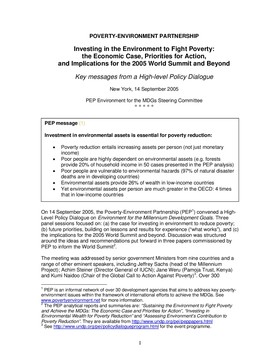POVERTY-ENVIRONMENT PARTNERSHIP Investing in the Environment to Fight Poverty: the Economic Case, Priorities for Action, and Implications for the 2005 World Summit and Beyond Key messages from a High-level Policy Dialogue New York, 14 September 2005
Document begins: POVERTY-ENVIRONMENT PARTNERSHIP Investing in the Environment to Fight Poverty: the Economic Case, Priorities for Action, and Implications for the 2005 World Summit and Beyond Key messages from a High-level Policy Dialogue New York, 14 September 2005 PEP Environment for the MDGs Steering Committee * * * * * PEP message (1) Investment in environmental assets is essential for poverty reduction: · Poverty reduction entails increasing assets per person (not just monetary income) · Poor people are highly dependent on environmental assets (e.g. forests provide 20% of household income in 50 cases presented in the PEP analysis) · Poor people are vulnerable to environmental hazards (97% of natural disaster deaths are in developing countries) · Environmental assets provide 26% of wealth in low-income countries · Yet environmental assets per person are much greater in the OECD: 4 times that in low-income countries On 14 September 2005, the Poverty-Environment Partnership (PEP1) convened a High- Level Policy Dialogue on Environment for the Millennium Development Goals. Three panel sessions focused on: (a) the case for investing in environment to reduce poverty; (b) future priorities, building on lessons and results for experience ("what works"), and (c) the implications for the 2005 World Summit ...
Cite this publication
Available at https://www.iied.org/g00288
